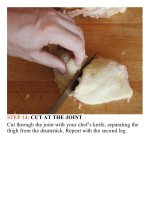The food lab better home cooking through science ( PDFDrive ) 762
Bạn đang xem bản rút gọn của tài liệu. Xem và tải ngay bản đầy đủ của tài liệu tại đây (63.98 KB, 2 trang )
DRYINGVERSUSSTALING
Dryingandstalingarenotthesamething.Here’s
thedifference:
• Drying involves the evaporation of moisture
fromwithinapieceofbread.Thestructureofthe
bread remains more or less the same, though it
become less pliable because of the moisture loss.
Dry, not stale, bread will be crisp like a cracker
and crumble into a fine powder. Bread that has
driedoutisveryhardtorefresh.
• Staling is the process by which moisture
migrates out of swollen starch granules and into
the spaces in the bread. The moisture-deprived
starch molecules then recrystallize, forming tough
structures within the bread. Stale, not dry, bread
willtasteleatheryandchewy,notcrackeryordry.
Bread that has staled can be refreshed by heating
it, causing the starch granules to reabsorb
moisture.
It’squitepossibleforbreadtostalewithoutdrying—
just think about what happens to a loaf of
preservative-free bread when you place it in the
refrigeratorovernight.Stalingactuallyoccursmuch
faster at cooler temperatures, which is why your
bread will become leathery and chewy by the next
morningnomatterhowtightlyitwaswrapped.
In order to prevent both staling and drying, it’s
best to store bread tightly wrapped on the
countertoporinabreadboxifyou’regoingtoeatit
within a day or two. For long-term storage, wrap
yourloavesinfoilandpop’emintothefreezer.This
will freeze the internal water molecules, preventing
them from migrating out of the bread and thus
stopping it from staling. Reheat frozen bread in a
300°F oven, wrapped in its foil, until warmed
through.









